Overview
- Brief Narrative
- Military style, brown, cloth pouch used by John (born Ivan Johann) Bolé, 29, in Buchenwald concentration camp where he was held as a Yugoslavian political prisoner from November 1944 until April 1945. John, a Catholic, was a lawyer in Laibach, Yugoslavia (Ljubljana, Slovenia) when the Axis powers, led by Nazi Germany, invaded in April 1941. Laibach was annexed by Italy. John went to Venice with the Slovenian Red Cross. In September 1944, he was arrested by the German SS for smuggling a radio transmitter into Trieste. In November, John was sent to Buchenwald in Germany and assigned prisoner number 67186. He was assigned to work commando A6 in Wanz-leben am See. The camp was liberated on April 11, 1945, by US troops. Germany surrendered on May 7. John lived as a displaced person in Garmisch-Partenkirchen, Germany, and immigrated to America in 1950.
- Date
-
use:
approximately 1944 November-1945 April
- Geography
-
use:
Buchenwald (Concentration camp);
Weimar (Thuringia, Germany)
- Credit Line
- United States Holocaust Memorial Museum Collection, Gift of Lorraine DeMaio
- Contributor
-
Subject:
John J. Bolé
- Biography
-
John (previously Ivan Johann, 1916-1978) Bolé was born in Prague, Czechoslovakia, to Catholic parents, Ivan and Danica Strekelj Bolé. The family moved to Laibach, Yugoslavia (Ljubljana, Slovenia). Danica died on November 14, 1929, in Laibach. John completed five years of university education. He received his diploma from the University of Ljubljana, Faculty of Law, in January 1941 and became an attorney. He spoke Czech, Slovenian, German, Italian, French, and Serbo-Croatian.
On April 6, 1941, the Axis powers, Germany, Italy, Hungary, and Bulgaria, invaded and divided Yugoslavia. Laibach was in the area occupied and annexed by Italy. John went to Venice, Italy, with the Slovenian Red Cross. On September 19, 1944, he was caught attempting to smuggle a radio transmitter across the border and was arrested by the German SS security force in Trieste. John was sent to Buchenwald concentration camp, arriving on November 19. He was designated a political prisoner, assigned prisoner number 67186, and housed in Block 17. He was assigned to work commando A6 in Wanz-leben am See. Buchenwald was liberated on April 11, 1945, by American forces. The war ended when Germany surrendered on May 7.
In June 1945, John was repatriated from Mittenwald displaced person camp to a DP camp in Rome, Italy. In 1946, he was employed by the Allied Military Government as a school director in the Gorizia region of Italy, near the Slovenian border. In fall 1948, John was living in Bagnoli DP camp near Naples, run by the IRO [International Refugee Organization.] On January 16, 1950, John left for the United States, sailing from Bremerhaven, Germany, on the General JH McRae, and arriving in New York on January 26. He became a naturalized American citizen in 1955 and changed his name to John. He went on to have a successful career in international banking. He married Martina, nee Kosuchowski, on May 4, 1957, and they had a son, Michael, and a daughter, Lorraine.
Physical Details
- Classification
-
Containers
- Category
-
Bags
- Object Type
-
Bags (lcsh)
- Physical Description
- Rectangular, light brown, cotton bag made from a single piece of cloth folded, hemmed, and sewn closed on the sides, with two finished buttonholes in the bottom corners. The top flap has three finished buttonholes for three silver-colored metal buttons on the center of the body, which are reinforced on the back with three small cloth squares. Letters and numbers are stamped on the flap interior. The cloth is stained.
- Dimensions
- overall: Height: 12.125 inches (30.798 cm) | Width: 14.000 inches (35.56 cm)
- Materials
- overall : cloth, metal, thread, ink
- Inscription
- flap interior, left corner, stamped, black ink : ADAbt26111
flap interior, right corner, stamped, black ink : ADGauXXV[?] 0135
Rights & Restrictions
- Conditions on Access
- No restrictions on access
- Conditions on Use
- No restrictions on use
Keywords & Subjects
- Topical Term
- Concentration camp inmates--Germany--Weimar--Biography. Political prisoners--Germany--Biography. Political prisoners--Yugoslavia--Biography. World War, 1939-1945--Italy--Trieste. World War, 1939-1945--Prisoners and prisons, German--Personal narratives. World War, 1939-1945--Underground movements--Personal narratives.
- Geographic Name
- Yugoslavia--History--Axis occupation, 1941-1945--Biography. Germany Italy
- Corporate Name
- Buchenwald (Concentration camp)
Administrative Notes
- Legal Status
- Permanent Collection
- Provenance
- Bolé, The bag was donated to the United States Holocaust Memorial Museum in 2011 by Lorraine DeMaio, the daughter of John Bolé.
- Funding Note
- The cataloging of this artifact has been supported by a grant from the Conference on Jewish Material Claims Against Germany.
- Record last modified:
- 2023-12-08 12:39:00
- This page:
- https://collections.ushmm.org/search/catalog/irn44119
Download & Licensing
In-Person Research
- By Appointment
- Request 21 Days in Advance of Visit
- Plan a Research Visit
- Request to See This Object
Contact Us
Also in John Bolé collection
The collection consists of four drawings, a cap, a pouch, a finger ring, and documents relating to the experiences of John Bolé (born Ivan Bolé) during the Holocaust in Buchenwald concentration camp, and after the Holocaust in displaced persons camps in Italy and Germany.
Date: 1942-1950
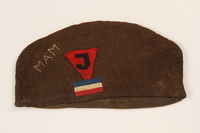
Brown hat with a triangular patch bearing a J and initials worn by John Bolé
Object
Brown cap with two patches worn by John (born Ivan Johann) Bolé, 29, in Buchenwald concentration camp from November 1944 until April 1945. The J (for Jugoslawisch) and the red inverted triangle indicated the wearer was a Yugoslavian political prisoner. The striped patch represents the Yugoslavian flag. John, a Catholic, was a lawyer in Laibach, Yugoslavia (Ljubljana, Slovenia) when the Axis powers, led by Nazi Germany, invaded in April 1941. Laibach was annexed by Italy. John went to Venice with the Slovenian Red Cross. In September 1944, he was arrested by the German SS for smuggling a radio transmitter into Trieste. In November, John was sent to Buchenwald in Germany and assigned prisoner number 67186. He was assigned to work commando A6 in Wanz-leben am See. The camp was liberated on April 11, 1945, by US troops. Germany surrendered on May 7. John lived as a displaced person in Garmisch-Partenkirchen, Germany, and immigrated to America in 1950.
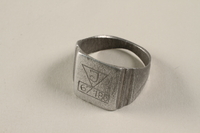
Aluminum ring with a letter and prisoner number owned by John Bolé
Object
Engraved, aluminum ring that belonged to John (born Ivan Johann) Bolé, who was imprisoned in Buchenwald concentration camp from November 1944 - April 1945. It is engraved with a J (Jugoslawisch) and an inverted triangle, the symbols Ivan was labelled with to identify him as a Yugoslavian political prisoner. John, a Catholic, was a lawyer in Laibach, Yugoslavia (Ljubljana, Slovenia) when the Axis powers, led by Nazi Germany, invaded in April 1941. Laibach was annexed by Italy. John went to Venice with the Slovenian Red Cross. In September 1944, he was arrested by the German SS for smuggling a radio transmitter into Trieste. In November, John was sent to Buchenwald in Germany and assigned prisoner number 67186. He was assigned to work commando A6 in Wanz-leben am See. The camp was liberated on April 11, 1945, by US troops. Germany surrendered on May 7. John lived as a displaced person in Garmisch-Partenkirchen, Germany, and immigrated to America in 1950.
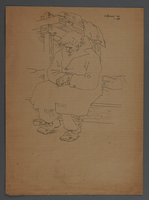
Drawing of a seated inmate in an overcoat by Nikolaj Pirnat acquired by John Bolé
Object
Double-sided portrait of a concentration camp prisoner by Nikolaj Pirnat acquired by John (previously Ivan Johann) Bolé. Pirnat was a Slovenian artist imprisoned at Gonars concentration camp in Italy from 1942-1943. John was imprisoned as a Yugoslavian political prisoner at Buchenwald concentration camp in Germany, from November 1944 to April 1945. It is unclear when or how he acquired the drawings. John, a Catholic, was a lawyer in Laibach, Yugoslavia (Ljubljana, Slovenia) when the Axis powers, led by Nazi Germany, invaded in April 1941. Laibach was annexed by Italy. John went to Venice with the Slovenian Red Cross. In September 1944, he was arrested by the German SS for smuggling a radio transmitter into Trieste. In November, John was sent to Buchenwald in Germany and assigned prisoner number 67186. He was assigned to work commando A6 in Wanz-leben am See. The camp was liberated on April 11, 1945, by US troops. Germany surrendered on May 7. John lived as a displaced person in Garmisch-Partenkirchen, Germany, and immigrated to America in 1950.
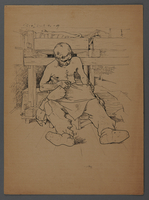
Drawing of an inmate repairing a shirt by Nikolaj Pirnat and acquired by John Bolé
Object
Double-sided portrait of a concentration camp prisoner by Nikolaj Pirnat acquired by John (previously Ivan Johann) Bolé. Pirnat was a Slovenian artist imprisoned at Gonars concentration camp in Italy from 1942-1943. John was imprisoned as a Yugoslavian political prisoner at Buchenwald concentration camp in Germany, from November 1944 to April 1945. It is unclear when or how he acquired the drawings. John, a Catholic, was a lawyer in Laibach, Yugoslavia (Ljubljana, Slovenia) when the Axis powers, led by Nazi Germany, invaded in April 1941. Laibach was annexed by Italy. John went to Venice with the Slovenian Red Cross. In September 1944, he was arrested by the German SS for smuggling a radio transmitter into Trieste. In November, John was sent to Buchenwald in Germany and assigned prisoner number 67186. He was assigned to work commando A6 in Wanz-leben am See. The camp was liberated on April 11, 1945, by US troops. Germany surrendered on May 7. John lived as a displaced person in Garmisch-Partenkirchen, Germany, and immigrated to America in 1950.
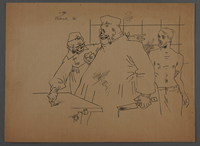
Drawing of two skeletal doctors with an imprisoned patient by Nikolaj Pirnat and acquired by John Bolé
Object
Drawing of two caricatured doctors and a concentration camp prisoner by Nikolaj Pirnat acquired by John (previously Ivan Johann) Bolé. Pirnat was a Slovenian artist imprisoned at Gonars concentration camp in Italy from 1942-1943. John was imprisoned as a Yugoslavian political prisoner at Buchenwald concentration camp in Germany, from November 1944 to April 1945. It is unclear when or how he acquired the drawings. John, a Catholic, was a lawyer in Laibach, Yugoslavia (Ljubljana, Slovenia) when the Axis powers, led by Nazi Germany, invaded in April 1941. Laibach was annexed by Italy. John went to Venice with the Slovenian Red Cross. In September 1944, he was arrested by the German SS for smuggling a radio transmitter into Trieste. In November, John was sent to Buchenwald in Germany and assigned prisoner number 67186. He was assigned to work commando A6 in Wanz-leben am See. The camp was liberated on April 11, 1945, by US troops. Germany surrendered on May 7. John lived as a displaced person in Garmisch-Partenkirchen, Germany, and immigrated to America in 1950.
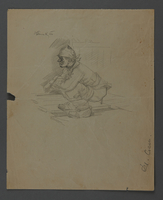
Drawing of a prisoner using a latrine by Nikolaj Pirnat and acquired by John Bolé
Object
Portrait of a prisoner defecating in a concentration camp latrine by Nikolaj Pirnat acquired by John (previously Ivan Johann) Bolé. Pirnat was a Slovenian artist imprisoned at Gonars concentration camp in Italy from 1942-1943. John was imprisoned as a Yugoslavian political prisoner at Buchenwald concentration camp in Germany, from November 1944 to April 1945. It is unclear when or how he acquired the drawings. John, a Catholic, was a lawyer in Laibach, Yugoslavia (Ljubljana, Slovenia) when the Axis powers, led by Nazi Germany, invaded in April 1941. Laibach was annexed by Italy. John went to Venice with the Slovenian Red Cross. In September 1944, he was arrested by the German SS for smuggling a radio transmitter into Trieste. In November, John was sent to Buchenwald in Germany and assigned prisoner number 67186. He was assigned to work commando A6 in Wanz-leben am See. The camp was liberated on April 11, 1945, by US troops. Germany surrendered on May 7. John lived as a displaced person in Garmisch-Partenkirchen, Germany, and immigrated to America in 1950.
John Bolé papers
Document
Wartime and immediate post-war documents illustrating Ivan/Johann's experiences in Buchenwald and post-war allied Europe.



